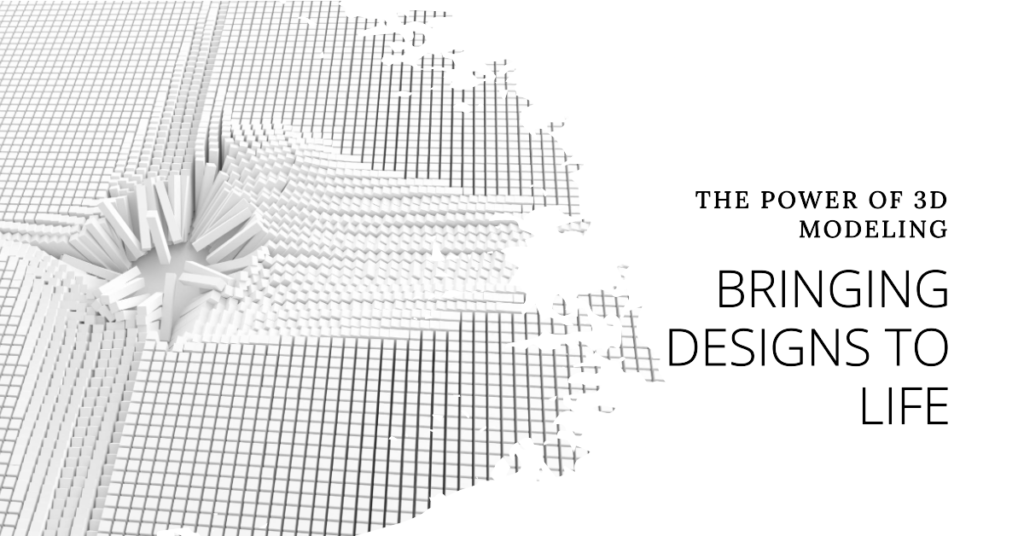
Table of Contents
Introduction to 3D Modeling:
In the realm of design, where imagination meets innovation, the power of 3D modeling reigns supreme. It’s not merely a tool but a gateway to bringing concepts to life with unparalleled precision and realism. From architectural marvels to intricate product prototypes, 3D modeling serves as the cornerstone of modern design processes. In this blog post, we delve deep into the transformative capabilities of 3D modeling and how it revolutionizes the way we visualize, create, and iterate designs.
Unlocking Creativity:
At the heart of every masterpiece lies creativity, and 3D modeling acts as a catalyst in nurturing and amplifying this creative spark. Unlike traditional 2D sketches, 3D modeling offers designers a multidimensional canvas to explore their ideas. With tools that mimic real-world physics and materials, designers can experiment freely, pushing the boundaries of what’s possible. Whether it’s sculpting organic forms or crafting intricate mechanical assemblies, the versatility of 3D modeling empowers designers to unleash their imagination like never before.
Enhancing Collaboration:
In the dynamic landscape of design, collaboration is key to success, and 3D modeling serves as a unifying platform for teams to converge and co-create. By providing a visual language that transcends barriers of interpretation, 3D models facilitate clearer communication among stakeholders, be it clients, engineers, or fellow designers. Through real-time feedback and iteration, teams can refine their designs iteratively, ensuring alignment with project objectives and user needs. In essence, 3D modeling fosters a culture of collaboration that fosters innovation and fosters innovation.
Precision and Accuracy:
In the pursuit of perfection, precision and accuracy are paramount, and 3D modeling stands as a beacon of reliability in this regard. By leveraging advanced algorithms and measurement tools, designers can achieve unprecedented levels of accuracy in their models, ensuring that every dimension and detail is meticulously crafted to perfection. Whether it’s creating prototypes for manufacturing or simulating structural integrity in architectural designs, the precision offered by 3D modeling minimizes errors and optimizes efficiency throughout the design process.


Iterative Design:
Design is an iterative journey, and 3D modeling provides the perfect vehicle for navigating through multiple iterations with ease. With the ability to quickly modify and refine designs, designers can explore a multitude of variations, fine-tuning each aspect until the desired outcome is achieved. This iterative approach not only accelerates the design process but also fosters a culture of continuous improvement, where each iteration builds upon the insights gained from the previous ones. Thus, 3D modeling empowers designers to embrace change and embrace change.
Realism and Visualization:
In the realm of design visualization, realism is paramount, and 3D modeling excels in its ability to create immersive virtual environments that mimic reality. Whether it’s rendering lifelike architectural visualizations or photorealistic product prototypes, 3D modeling blurs the line between the digital and physical worlds, offering stakeholders a glimpse into the future. By harnessing lighting, textures, and animations, designers can evoke emotions and evoke emotions, eliciting visceral reactions that transcend mere visualization.
Streamlining Production:
In the fast-paced world of manufacturing, efficiency is the name of the game, and 3D modeling streamlines production processes like never before. By creating digital prototypes that can be easily modified and optimized, designers can accelerate the transition from concept to production, reducing time-to-market and minimizing costs. Furthermore, 3D models serve as invaluable assets throughout the entire production lifecycle, from toolpath generation in CNC machining to mold design in injection molding. Thus, 3D modeling revolutionizes production workflows, unlocking new levels of efficiency and agility.
Accessibility and Democratization:
Gone are the days when 3D modeling was confined to the realm of experts and specialists. Thanks to advancements in technology and user-friendly software tools, 3D modeling has become more accessible and democratized than ever before. From hobbyists tinkering in their garages to students learning the ropes in classrooms, people from all walks of life can now harness the power of 3D modeling to bring their ideas to life. This democratization of design not only fosters innovation but also fosters inclusivity, empowering individuals to participate in the creative process regardless of their background or expertise.
Conclusion:
In conclusion, the transformative power of 3D modeling transcends mere pixels and polygons, redefining the way we conceive, create, and communicate designs. From unleashing creativity to streamlining production, 3D modeling serves as a catalyst for innovation across industries and disciplines. As we embrace the limitless possibilities of this technology, let us embark on a journey where imagination knows no bounds, and every design dream becomes a tangible reality.



